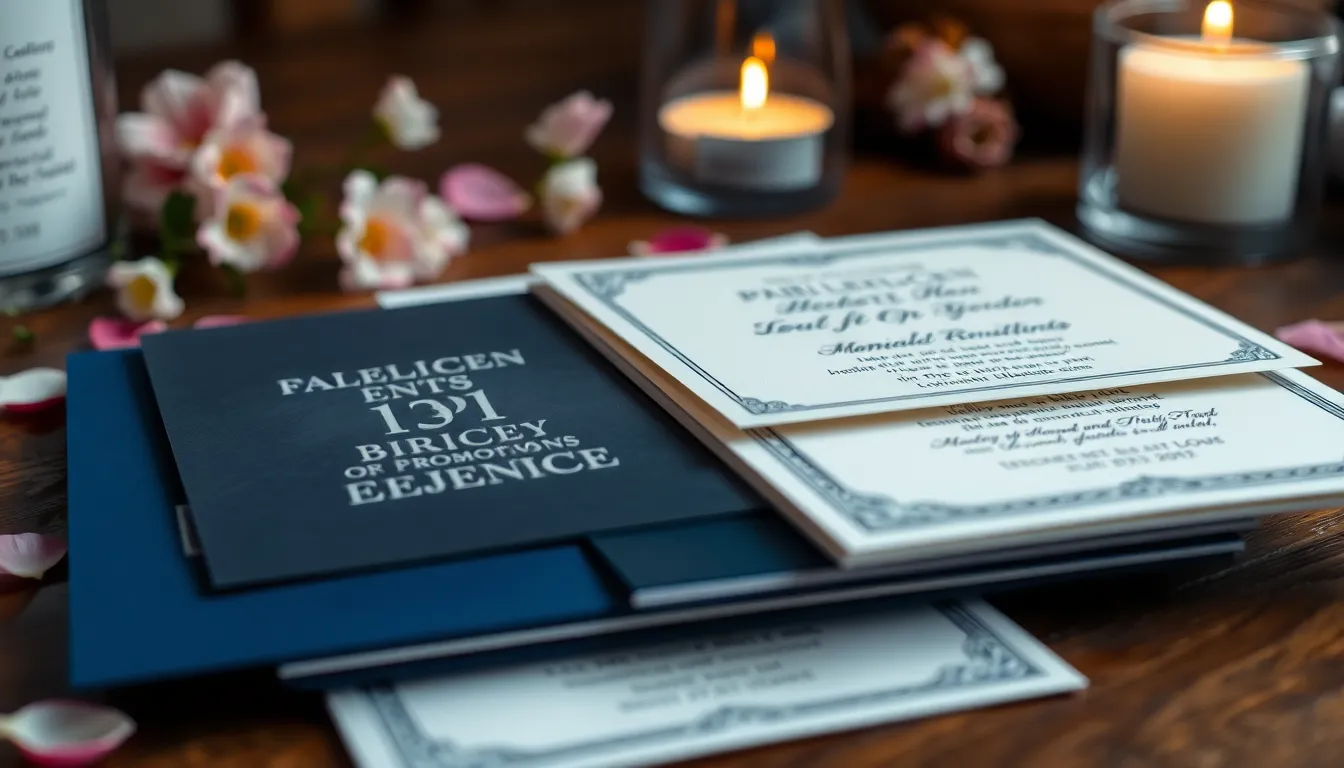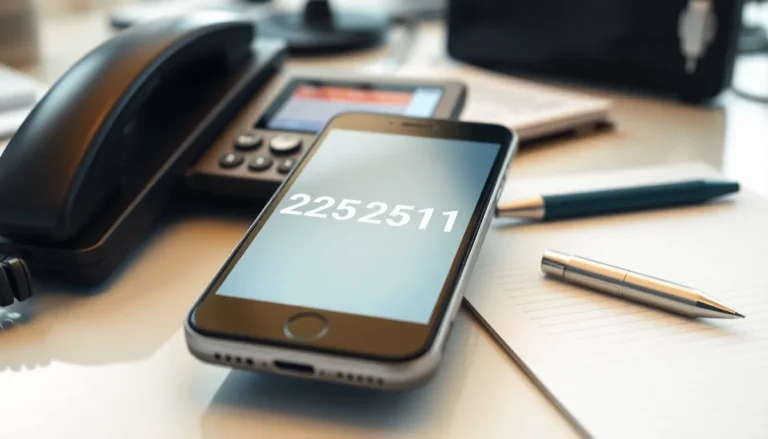In a world where digital invites are just a click away, there’s something undeniably charming about the tactile experience of a beautifully printed invitation. It’s like sending a little piece of joy through the mail, wrapped in a hint of anticipation. Whether it’s a wedding, birthday bash, or a quirky get-together, invitation printing adds a personal touch that says, “You’re worth the effort.”
Imagine your guests’ faces lighting up as they peel open that envelope, revealing a stunning design that reflects the theme of your event. With countless styles and finishes to choose from, invitation printing transforms a simple announcement into a cherished keepsake. So why settle for a bland e-vite when you can make a statement that’ll have everyone talking? Let’s dive into the world of invitation printing and discover how to make your next event unforgettable.
Table of Contents
ToggleWhat Is Invitation Printing?
Invitation printing encompasses the process of creating tangible invites for various occasions. Events such as weddings, birthdays, and corporate gatherings often utilize printed invitations to set the tone and theme. The tactile quality of a printed invitation offers a personal touch that digital formats lack. Designs can range from classic elegance to modern simplicity, allowing hosts to reflect their unique style.
Specialty printing techniques enhance the beauty of invitations. Options like foil stamping, embossing, or letterpress provide distinctive textures and visual appeal. These methods contribute to an invitation’s overall impact, making it not just a piece of paper, but a significant element of event planning.
Materials play a crucial role in invitation printing. High-quality cardstock, for instance, ensures durability while adding a luxurious feel. Various finishes, such as matte or glossy, can affect how colors appear and influence the emotional response of recipients.
Timing is essential for printing invitations. Engaging a printing service well in advance avoids last-minute stress and allows for adjustments. Many services offer design assistance, enabling clients to tailor their invites perfectly.
Many online platforms now offer customizable templates, allowing users to design unique invitations from the comfort of home. Options like digital proofs help visualize the final product before print, ensuring satisfaction with the design.
Ultimately, invitation printing transforms a basic announcement into a cherished keepsake. The commitment to a printed invite suggests thoughtfulness and care, leaving a lasting impression on guests.
Types of Invitation Printing

Various invitation printing methods cater to different design preferences and budgets. Understanding these options helps in choosing the best approach for specific events.
Digital Printing
Digital printing offers quick turnaround times and high-quality results. This method works well for both small and large runs, making it cost-effective. It employs digital files to produce vibrant colors and intricate designs. Customization stands out, as each invitation can feature unique text and graphics. Businesses and individuals frequently prefer digital printing for its flexibility and efficiency.
Offset Printing
Offset printing delivers exceptional quality and precise details, ideal for bulk orders. This method uses metal plates to transfer ink onto paper, ensuring consistent color and sharp images. While it requires a higher initial setup cost, larger quantities result in lower per-unit prices. This technique suits fancy events like weddings and galas, where visual appeal matters significantly. Robust paper options and vibrant ink choices enhance the final product.
Letterpress Printing
Letterpress printing provides a tactile quality that adds elegance to invitations. It employs a relief printing technique, which presses inked plates into the paper, creating an impression. This method often uses thick, textured paper, making each invite feel luxurious. Letterpress also allows for unique designs and typography that stand out. Perfect for formal events, it combines traditional craftsmanship with modern design sensibilities.
Design Considerations
Designing an invitation involves thoughtful choices that set the tone for any event. Elements such as theme, font, and color play crucial roles in achieving the desired effect.
Choosing the Right Theme
Selecting a theme creates consistency across all invitation elements. Consider the event’s nature and the audience’s preferences. A whimsical theme suits children’s parties, while a classic theme works well for weddings. Matching the theme to the celebration establishes expectations for guests. Use inspiration from the event location or personal interests to spark creativity in design.
Selecting Fonts and Colors
Fonts and colors significantly impact the invitation’s visual appeal. Choose fonts that reflect the event’s mood; elegant script fonts convey formality, while bold sans-serif fonts suggest a modern feel. Colors should align with the theme and evoke an emotional response. Soft pastels create an inviting atmosphere for brunch events, while vibrant hues can energize birthday celebrations. Experiment with color combinations to find a harmonious balance that enhances the overall design.
The Printing Process
The printing process for invitations involves multiple stages that ensure a high-quality final product. Each step plays a critical role in transforming ideas into tangible invites.
Preparing the Artwork
Artwork preparation serves as the foundation for invitation printing. Designers create visual assets using software like Adobe Illustrator or Photoshop. High-resolution images and vector files will yield the best results. It’s essential to follow specific guidelines provided by the printing service, such as bleed and trim marks. Choosing the right color model, like CMYK for print, enhances color consistency. Once ready, designers save and export the artwork according to the printer’s requirements.
Proofing and Approval
The proofing stage ensures accuracy and quality before final printing. Printers send a digital or physical proof for review. Clients should carefully examine the proof for text errors or design flaws. Taking the time to check for color discrepancies and alignment issues is vital. Clients can request adjustments until they’re satisfied. After approval, the artwork moves to the final printing phase. This step eliminates uncertainties and ensures the final product meets expectations.
Final Printing and Finishing
Final printing and finishing bring the invitation to life. Printers use chosen methods like digital or offset printing based on client specifications. Materials such as cardstock are selected to match the desired aesthetic and tactile quality. After printing, additional finishing touches may involve cutting, folding, or special techniques like embossing. These steps enhance the overall appearance and durability of the invitations. Paying attention to these details contributes to a striking final result that captivates recipients.
Conclusion
Printed invitations offer a unique charm that digital formats simply can’t replicate. They provide a tangible connection to special moments and serve as lasting mementos for guests. By choosing the right design and printing method, hosts can elevate their events and create an unforgettable experience.
The process of invitation printing allows for creativity and personalization, ensuring that each invite reflects the essence of the occasion. With various materials and techniques available, the possibilities are endless. Ultimately, investing in printed invitations is a thoughtful way to make any event more memorable and meaningful.





